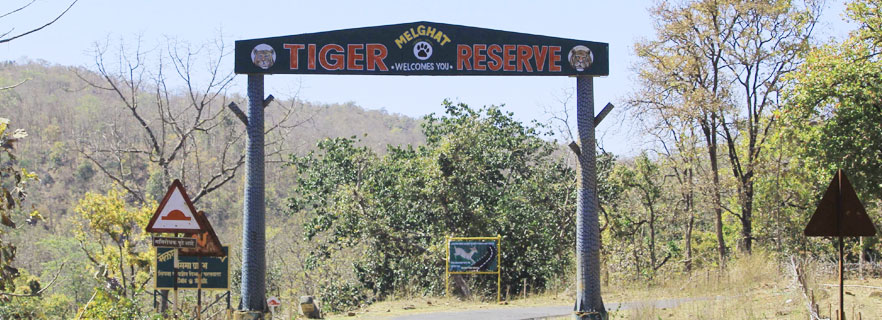General Information About Melghat Tiger Reserve
Are you an adventure lover longing for a stroll amongst the wilderness, then experience the nocturnal beauty of woods, experience the beauty of delicate flora and magnificence of diversified fauna, come across thousands of unheard species of flowers, trees, shrubs, birds, animals and extinguishing species? Have you been planning to have a fabulous weekend away from the city crowd and hastiness into woods, campaigning? Experience the mystique wonderfulness of the wilderness and the serene calmness of the nature, which doesn’t only make you feel relieved but gives an unforgettable time for the whole life.
Melghat tiger reserve is what we are talking about. In the state of Maharashtra, Melghat Tiger reserve is situated in northern part of Amravati district, this forest was declared to be a Tiger Reserve in 1973-74, for the first time nine tiger reserves were notified under a project named Project Tiger. This tiger reserve have been developing since then and is now a popular tourist place for both Indian and foreign tourists.
Melghat tiger reserve is embraced to have Tapi River flowing through the northern end of the reserve, it adds a glory to the beauty of the reserve and is also a major water resource to the animals of reserve. Though popular house for the tigers, it is a home of a wide variety of wildlife, flora and fauna. The core area of the Melghat Tiger reserve is formed by Gugamal National Park, which covers the most of the area as much as 361.28 km2 since 1987. Along the boundary of the reserve the three major landmarks, which are present, are Gawilgadh ridge, The Tapti Riverand and Satpura Range.
Situated at the north extreme of Amravati district, Melghat lies in the foot of South-Western Satpura mountain range. The Melghat reserve offers a scenic beauty comprising of all sorts of wonder of nature, the clear rivers passing through the reserve, the large and unending chain of hills and valleys, the mountains are carved with jagged cliffs and steep climbs which makes the tour more adventurous and loving. Extremely close to the nature, Melghat Reserve was declared to be a Tiger Reserve in 1974; the area covered today by the reserve is about 1700 Km2. The concern towards the tiger’s protection and survival is the prime concern of this reserve therefore no villages can be found in the core area.
The forests in the Melghat reserve is tropical dry deciduous type, which is dominated by Teak, moreover the forest covers as much as 70% area of the reserve with dense forests in the core area. The reserve also proves to be a catchment area for five seasonal rivers, which are tributaries of the river Tapti, these rivers are: the Khandu, Sipna, Dolar, Khapra and Gadga. The reserve area is also a habitat for a large population, there are 61 villages, which are in reserve area, but all are outside the core area. The distribution of the villages have been done on the basis of its usage, 22 are said to fall in Buffer Zone while 39 are in an area marked as the Multiple Use Area. Buffer zone is though more close to the core area while Multiple Use Area forms the outer boundary of the reserve.
Human Population of Buffer area is quite less as compared to the Multiple Use Area zone, while only 11024 lives in Buffer zone, Multiple Use Area is home to about 15642 humans according to the 1994 census. This particular zone where the people live gives an entirely different view of the human culture, the inhabitants of the reserve are mainly tribal, the largest tribe being Korku Tribe which accounts for as much as 80% of the entire population, rest 20% comprises of tribes such as Halbi, Gaolan, Wanjari, Gond, Gawali, Balai and Nihal. These tribes survive in a rich heritage of nature away from the gadgets, technology and the city chaos; all the inhabitants of this reserve depend on the forest for their day-to-day requirements and domestic need.
Firewood, medicinal plants, fodder, timber and non-timber products such as gum, flowers, fruits and medicinal plants, all are derived and taken from the forest. The tribal people depend on labor and rainy season agriculture for income. They also depend on wood and their products for earning money by selling the non-timber products such as tendu-leaves, gumcula, charoli, Mahauli, Musali, flowers, dhawada and seeds.
Best time to visit Melghat Tiger Reserve
December to May is considered as the best season to visit and witness the soothing and comfortable environment of the reserve, the temperature during the winter season may drop even below 150C. During the monsoon the rainfall is between 1000 to 2,250 mm of rainfall. During the winter season, animals are in most prime condition and make the view extremely adorable. The wildlife viewing becomes a pleasure during this time when the grass is tall enough and Tigers can be viewed lying within just a few meters of forest trail.
 India
India







